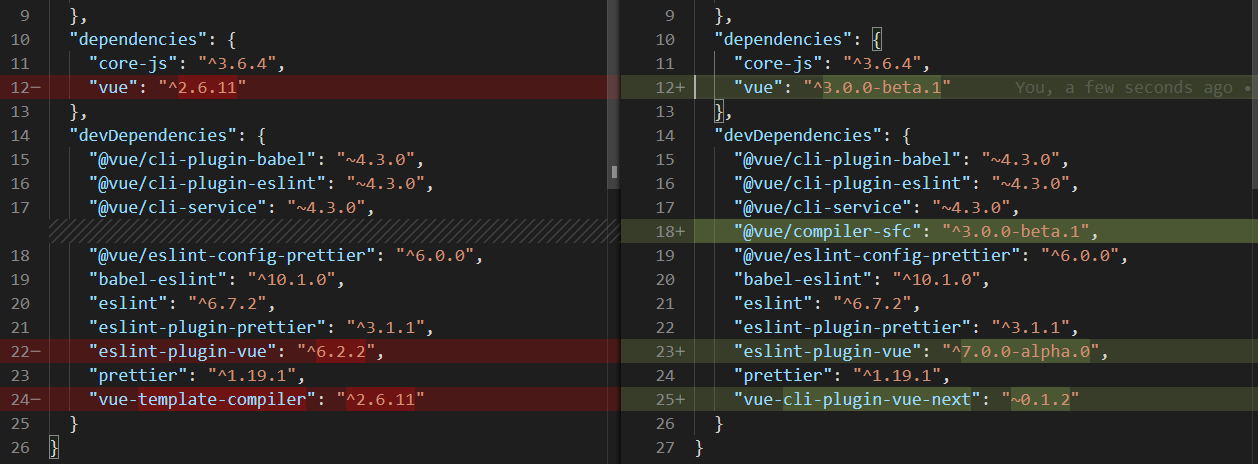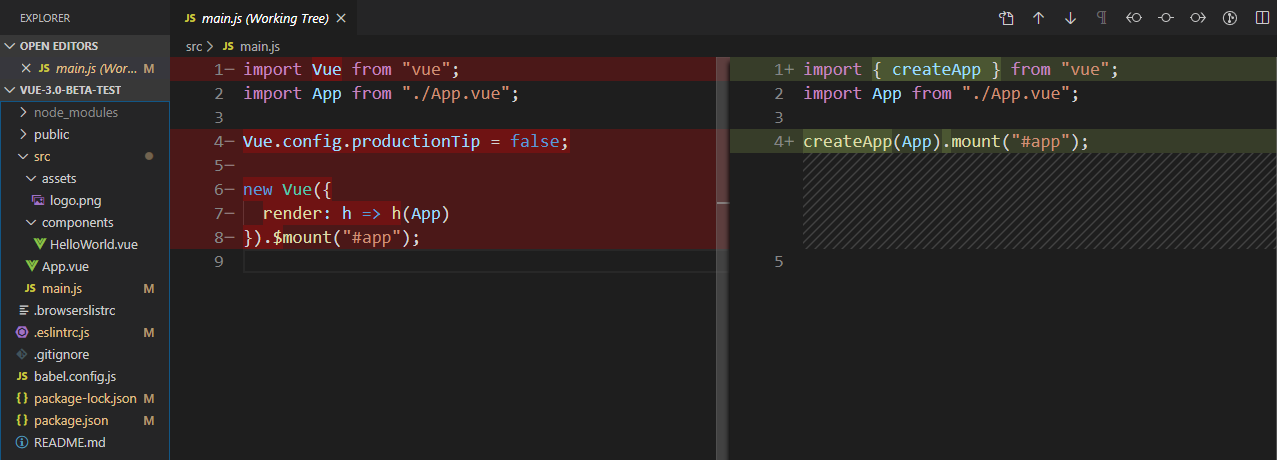本文最后更新于:2020年5月3日 凌晨
前言
尤大大前段时间发布了vue3.0-beta版本,现在趁着五一假期尝尝鲜,记录一下。
vue3设计更新点
先回顾官方提出的vue3.0设计目标
- 更小
- 全局 API 和内置组件
- 支持 tree-shaking
- 常驻代码大小控制在 10kb gzipped 左右
- 更快
- 基于 Proxy 的变动侦测
- Virtual DOM 重构
- 编译器架构重构,更多的编译时优化
- 加强API设计一致性
- 加强TypeScript支持
- 提高自身可维护性
- 代码采用 monorepo 结构,内部分层更清晰
- TypeScript 使得外部贡献者更有信心做改动
- 开放更多底层功能
开始
创建项目
1
2
3
4
5
6
7
8
|
cnpm install -g @vue/cli
vue create vue-3.0-beta-test
vue add vue-next
|
然后打开项目,可以看到vue的版本已经变成^3.0.0-beta.1,还有一些插件版本的更新和新增了两个插件

对比项目结构
再从项目的整体结构来看,对比2.x版本基本没有变化,主要看下变化了的main.js文件

通过图片可以看到,这里只解构出一个createApp函数,因为vue3.0支持tree-shaking,可以把每一个用到的API抽取出来,让vue变得更小
Composition API
原先是叫Vue-Function-API,后面经社区意见收集,更改为Vue-Composition-API,这里面有几个变化比较大的:
- 生命周期钩子
- reactive API
- ref API
- watch API
- computed API
生命周期
在3.0中,生命周期发生了很大变化:
| 2.x |
3.0 |
| beforeCreate |
setup |
| created |
setup |
| beforeMount |
onBeforeMount |
| mounted |
onMounted |
| beforeUpdate |
onBeforeUpdate |
| updated |
onUpdated |
| beforeDestroy |
onBeforeUnmount |
| destroyed |
onUnmounted |
reactive
该API作用是创建响应式对象,类似之前在data中声明变量
1
2
3
4
5
6
7
8
9
10
11
12
13
14
15
16
17
18
19
20
21
22
| // App.vue
<template>
<div id="app">
<img alt="Vue logo" src="./assets/logo.png" />
<h3>{{ info.msg }}</h3>
</div>
</template>
<script>
import { reactive } from "vue";
export default {
name: "App",
setup() {
let info = reactive({
msg: `vue3.0-beta尝鲜`
});
return {
info
};
}
};
</script>
|
效果:

ref
创建一个包装式对象,含有一个响应式属性value,通过修改value来修改值
1
2
3
4
5
6
7
8
9
10
11
12
13
14
15
16
17
18
19
20
21
22
23
24
25
26
27
| // App.vue
<template>
<div id="app">
<img alt="Vue logo" src="./assets/logo.png" />
<h3>{{ info.msg }}</h3>
<h3>{{ tip }}</h3>
</div>
</template>
<script>
import { reactive, ref } from "vue";
export default {
name: "App",
setup() {
let info = reactive({
msg: `vue3.0-beta尝鲜`
});
let tip = ref(`value of ref`);
// 通过修改value属性来修改值
tip.value = `change ref of value`;
return {
info,
tip
};
}
};
</script>
|
效果:

事件处理
3.0没有methods对象,也是写在setup里面
1
2
3
4
5
6
7
8
9
10
11
12
13
14
15
16
17
18
19
20
21
22
23
24
25
26
27
28
29
30
31
32
33
34
| // App.vue
<template>
<div id="app">
<img alt="Vue logo" src="./assets/logo.png" />
<h3>{{ info.msg }}</h3>
<h3>tip:{{ tip }}</h3>
<input v-model="inputValue" />
<button @click="handleClick">click me</button>
</div>
</template>
<script>
import { reactive, ref } from "vue";
export default {
name: "App",
setup() {
let info = reactive({
msg: `vue3.0-beta尝鲜`
});
let tip = ref(`value of ref`);
tip.value = `change ref of value`;
let inputValue = ref("");
const handleClick = () => {
tip.value = inputValue.value;
};
return {
info,
tip,
inputValue,
handleClick
};
}
};
</script>
|
上面写了一个方法,绑定一个点击事件来改变变量tip的值,效果如图:

onMounted钩子
我们在vue项目中用得最多的生命钩子就是created和mounted,在created发送请求,接收、处理参数之类,在mounted页面渲染后进行相关的业务处理,在上面有提过,现在beforeCreate和created 都是setup了,现在看下新的onMounted怎么用:
1
2
3
4
5
6
7
8
9
10
11
12
13
14
15
16
17
18
19
20
21
22
23
24
25
26
27
28
29
30
31
32
| <template>
<div id="app">
<img alt="Vue logo" src="./assets/logo.png" />
<h3>{{ info.msg }}</h3>
<h3>tip:{{ tip }}</h3>
<input v-model="inputValue" />
<button @click="handleClick">click me</button>
</div>
</template>
<script>
import { reactive, ref, onMounted } from "vue";
export default {
name: "App",
setup() {
// 省略上面例子的代码
// ...
onMounted(() => {
console.log(`mounted`);
// 页面渲染完 获取所有h3元素
let h3List = document.querySelectorAll("h3");
console.log({
h3List: h3List
});
});
return {
// ...
};
}
};
</script>
|
computed
1
2
3
4
5
6
7
8
9
10
11
12
13
14
15
16
17
18
19
20
21
22
23
24
25
26
27
28
29
30
31
32
33
34
35
| <template>
<div id="app">
<img alt="Vue logo" src="./assets/logo.png" />
<h3>{{ info.msg }}</h3>
<h3>tip:{{ tip }}</h3>
<h3>computed num:{{ num }}</h3>
<input v-model="inputValue" />
<button @click="handleClick">click me</button>
<button @click="incrementNum">increment</button>
</div>
</template>
<script>
import { reactive, ref, onMounted, computed } from "vue";
export default {
name: "App",
setup() {
// ...
let initNum = ref(0);
const incrementNum = () => {
initNum.value++;
};
// 让num成为计算属性
let num = computed(() => {
return initNum.value * 2;
});
return {
// ...
incrementNum,
num
};
}
};
</script>
|
看下效果:

总结
从上面的例子可以看到,3.0的语法更加简洁精炼!总的来说,3.0会兼容2.x,我们的学习成本基本就只集中在composition这一块,而更具体、更详细的内容,可访问composition-api,上面还有很丰富的内容等着我们探索,包括对TypeScript的更好支持等。





